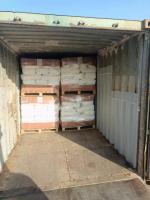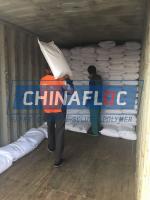Our Products
Oilfield Chemicals / The equivalent model of Flopaam 3630s used for enhanced oil recovery

Enhanced Oil Recovery (EOR) refers to the methods used to extract oil from reservoirs that are no longer productive using primary or secondary recovery techniques. These methods aim to increase the amount of crude oil that can be extracted from a reservoir after the natural pressure of the reservoir has been depleted and water flooding, typically employed during secondary recovery, has been implemented. The application of anionic polyacrylamide (PAM) in EOR plays a significant role in improving the efficiency of oil extraction processes, particularly in water flooding and other chemical EOR techniques.
What is Anionic Polyacrylamide (PAM)?
Anionic polyacrylamide (PAM) is a water-soluble polymer made from the polymerization of acrylamide with a small amount of its anionic derivatives. The anionic nature of the polymer arises due to the incorporation of negatively charged groups, typically carboxyl groups (-COOH), into the polymer chain. These negative charges give anionic polyacrylamide distinct characteristics in its interactions with oil, water, and rock formations, making it useful in various industrial applications, particularly in the oil industry.
Role of Anionic Polyacrylamide in EOR
In Enhanced Oil Recovery (EOR), the primary goal is to increase the oil recovery factor from a reservoir. Anionic polyacrylamide is used in several EOR techniques, with a particular focus on improving the mobility and sweep efficiency of injected fluids. Below are the main applications of anionic polyacrylamide in EOR processes:
1. Polymer Flooding (Water Flooding Enhancement)
Polymer flooding, one of the most widely used EOR techniques, involves the injection of polymer solutions into an oil reservoir to increase the viscosity of the injected water. This helps to improve the mobility ratio between the injected water and the crude oil, thereby reducing water breakthrough and improving the sweep efficiency of the injected fluids.
Anionic polyacrylamide is often used in polymer flooding because it enhances the viscosity of the injected water and reduces the mobility of the water relative to the oil. This adjustment in viscosity ensures that the water moves more uniformly through the reservoir, displacing the oil more efficiently. Anionic PAM is particularly useful in reservoirs with high permeability variations, as it helps in improving the displacement of oil from areas with high permeability and prevents excessive water flow in low-permeability zones.
The anionic charge of the polymer also helps to stabilize the water-oil interface and reduces the capillary pressure between water and oil, making it easier for the oil to be displaced from the reservoir rock. This results in increased oil recovery while reducing the risk of premature water breakthrough.
2. Increasing Sweep Efficiency
Sweep efficiency refers to the effectiveness with which the injected fluid (typically water) displaces oil throughout the reservoir. In traditional water flooding, the injected water often follows the path of least resistance, bypassing large portions of the oil reservoir. As a result, some areas of the reservoir may not be adequately swept, leading to a lower overall recovery factor.
Anionic polyacrylamide improves sweep efficiency by increasing the viscosity of the injected water. The increased viscosity helps the water to move more uniformly through the reservoir, ensuring a more thorough displacement of oil. By adjusting the viscosity, anionic PAM can also reduce the tendency for the injected fluid to channel through high-permeability zones, ensuring that more of the reservoir is swept and more oil is recovered.
3. Reduction of Frictional Losses
When water or any fluid is injected into a reservoir, frictional losses occur due to the resistance between the fluid and the rock. This resistance can significantly reduce the efficiency of fluid injection and the overall effectiveness of EOR processes.
Anionic polyacrylamide helps to reduce frictional losses by increasing the viscosity of the injected fluid. The higher viscosity creates a smoother flow, reducing the energy required to inject the fluid into the reservoir. This can be particularly beneficial in deep reservoirs or those with high permeability, where high injection pressures would typically be required to overcome friction.
By reducing frictional losses, anionic PAM not only improves the efficiency of the EOR process but also helps reduce the operational costs associated with fluid injection.
4. Control of Water Injection Rates
One of the challenges in EOR is maintaining consistent water injection rates to optimize oil displacement. Anionic polyacrylamide can be used to regulate the flow rate of injected water, ensuring that the correct amount of water is injected at a steady rate over time. This is particularly important in reservoirs where water influx rates are variable, and precise control of the injection process is essential for maximizing oil recovery.
Anionic PAM is particularly useful in controlling the flow rate in reservoirs with highly heterogeneous permeability. The polymer helps to plug high-permeability zones and forces the injected water to flow through low-permeability areas, thus improving the overall sweep efficiency.
5. Reduction of Emulsion Formation
Emulsions (mixtures of oil and water) often form during the injection of water into an oil reservoir. These emulsions can cause operational difficulties, such as clogging of the reservoir rock, equipment, and pipelines, reducing the overall efficiency of the EOR process.
Anionic polyacrylamide can help mitigate emulsion formation by stabilizing the interface between oil and water. The polymer's anionic nature helps to reduce the surface tension and interfacial tension between oil and water, preventing the formation of stable emulsions. This reduces the risk of blockage and improves the overall efficiency of the EOR process.
6. Viscosity Control in Miscible Displacement EOR
In some EOR processes, such as CO2 or gas flooding, the injected fluid must be miscible with oil to displace it effectively. However, the viscosity of the injected fluid can affect the mobility and efficiency of the displacement process.
Anionic polyacrylamide can be used to adjust the viscosity of the injected fluid in miscible displacement processes. By increasing the viscosity of CO2 or other gases, PAM ensures that the fluid moves more uniformly through the reservoir, improving the displacement of oil and reducing the risk of gas channeling through high-permeability zones.
7. Environmental Benefits and Cost-Effectiveness
Anionic polyacrylamide is considered relatively environmentally friendly compared to other chemical agents used in EOR. It is non-toxic and can be easily broken down in the environment, making it an attractive option for reducing the environmental impact of EOR operations. This makes it suitable for use in environmentally sensitive areas or regions with strict environmental regulations.
Moreover, anionic PAM is cost-effective compared to other polymers or chemicals used in EOR. Its high performance, coupled with its relatively low cost, makes it a popular choice for oil companies seeking to improve the efficiency of their recovery operations without significantly increasing operational expenses.
Conclusion
Anionic polyacrylamide (PAM) has proven to be a valuable tool in the field of Enhanced Oil Recovery (EOR). By increasing the viscosity of injected water, reducing frictional losses, improving sweep efficiency, and controlling the water injection process, anionic PAM enhances the overall efficiency of oil recovery operations. Its ability to stabilize the water-oil interface, reduce emulsion formation, and regulate flow rates makes it a versatile and effective solution for a wide range of EOR applications.
As oil reservoirs become more depleted and difficult to manage, the role of polymers like anionic polyacrylamide in EOR will only grow. With its environmental benefits and cost-effectiveness, it is likely that anionic PAM will continue to be a critical component in maximizing oil recovery from challenging reservoirs, ultimately improving the economic viability of oil extraction projects worldwide.



492_small.jpg)
285_small.jpg)
